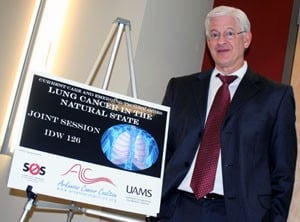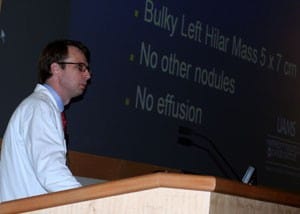UAMS Hosts Lung Cancer Symposium
June 23, 2010 | Health care professionals and other spectators nearly filled the large auditorium at the I. Dodd Wilson Education Building on the University of Arkansas for Medical Sciences’ (UAMS) campus June 11 to get the latest information in diagnosing and treating lung cancer. Co-sponsored by several health organizations, the “Lung Cancer in the Natural State” symposium offered separate and joint sessions for health care professionals and the general public. “Lung cancer remains the leading cause of death due to cancers among men and women in Arkansas and in the United States,” said Thad Bartter, M.D., professor and director of Interventional Pulmonology within the Pulmonary and Critical Care Division of the College of Medicine at UAMS. “It’s of utmost urgency to be sure to disseminate the latest medical developments among those who can make a difference in patient care and educational avenues.” The daylong conference provided an updated review of the multidisciplinary approach of diagnosing, staging and treating patients with lung cancer. Those in attendance heard lung cancer experts describe current treatments, new surgical and non-surgical technologies, tobacco cessation efforts and what lies ahead in patient care. Matthew Steliga, M.D., a thoracic surgeon who specializes in minimally invasive surgical procedures for lung and esophageal cancer at UAMS, said lung cancer experts in Arkansas face a daunting task. “An estimated 2,160 Arkansans will die of lung cancer this year, according to the American Cancer Society,” he said. “That compares to 580 deaths from colon and rectum cancer, the next deadliest cancer, and 410 deaths from breast cancer. There is a lot of work to be done and having all of these people in the same room allows us to be on the same page as we fight those statistics.” Lung cancer grows and spreads without causing symptoms that are easily detected until it’s too late. “If lung cancer is caught early, it’s usually by happenstance,” Bartter said. For example, an X-ray for a rib injury might reveal early-stage lung cancer. Only about 16 percent of lung cancer is caught early enough to be removed, and only 49 percent of those patients will be alive five years later. Sessions for the general public included information on access to lung cancer care, the severity of lung cancer in Arkansas, techniques for screening, detection and treatment, and smoking cessation resources. Physicians, researchers and cancer survivors were on hand for discussion. Sessions for health care professionals included new and emerging surgical and nonsurgical technologies, tobacco cessation, recent changes in the disease staging system and other related areas. The symposium was sponsored by the Arkansas Cancer Coalition; and the Arkansas Department of Health – Tobacco Prevention and Cessation Program and the UAMS College of Medicine Departments of Surgery, Internal Medicine, and Family and Preventive Medicine. |

